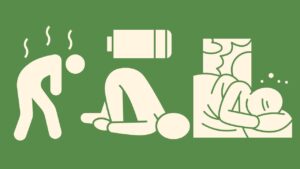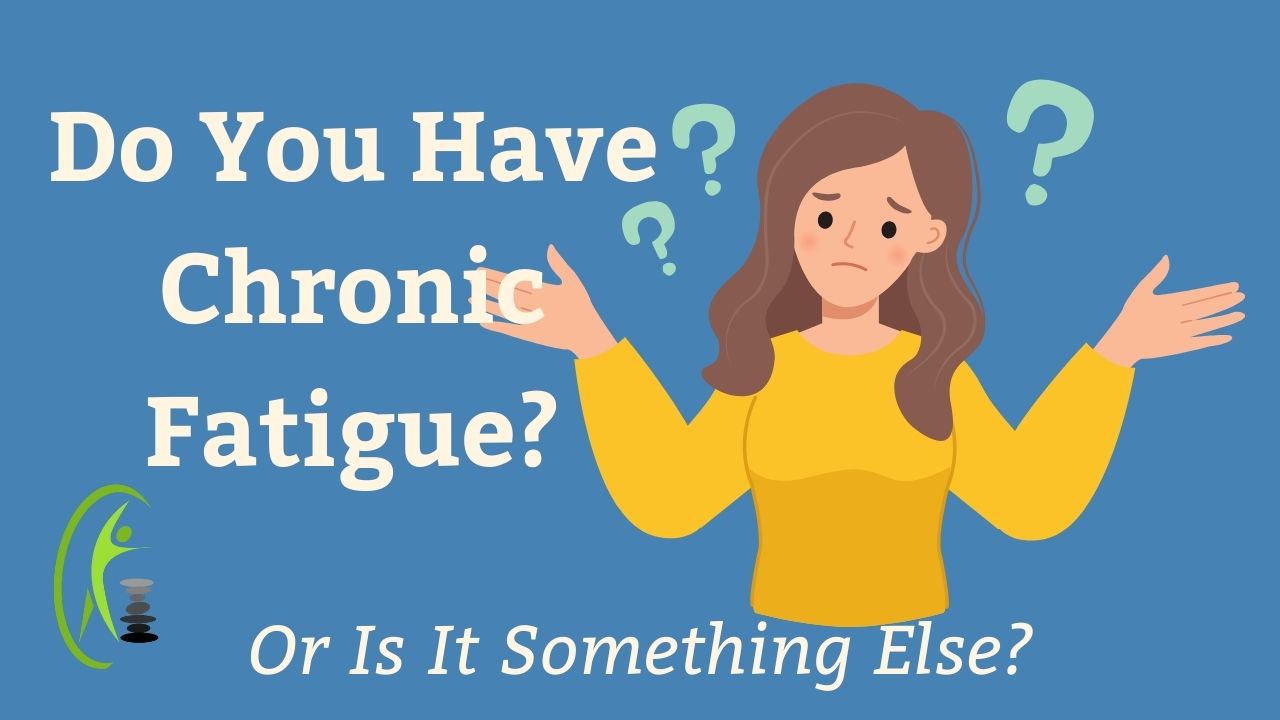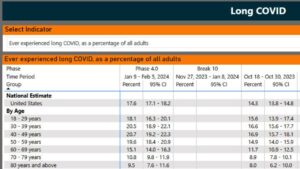To Listen to Audio-Click Here
In 2021, our health took a turn, with chronic fatigue becoming more prevalent. This marked a notable shift, as it was the first time the CDC recognized the significance of chronic fatigue, prompting efforts to understand its scope. Their findings revealed that approximately 3.3 million individuals in the United States are affected by this condition (3).
Long Covid Cases Increasing Rapidly
Moreover, recent data suggests that this number might be on the rise, potentially due to the surge in cases of long COVID. According to a CDC survey conducted in January 2024, an alarming 6.8% of the U.S. population, totaling 17.6 million individuals, have reported experiencing long COVID symptoms.
Furthermore, since four months ago, in October 2023, there has been an increase of 3% in the number of individuals reporting long-term COVID-19 symptoms (4). If that trend continues, we could double the long Covid numbers by the end of the year. Of note, women are disproportionately affected by long COVID, with 21% of surveyed women reporting symptoms compared to only 14% of men surveyed (4).
How about the age range most impacted by long Covid? It is the 30-50-year-olds. An average of about 21% of the respondents in this age range reported long Covid symptoms. That is a 3% increase from just four months ago in October 2023 (4).
Why am I looking at this 30-50 year old age range?
Something significant has happened to this age range, specifically to their immune system, which may be more compromised than other age ranges. Every time I see a new disease or bacteria emerge, it seems like the 30-50-year-olds are being adversely impacted more than anyone else.
Initially, amidst the vast array of information circulating online, there was chatter about concerning trends affecting individuals between the ages of 30 and 50. Scientists, researchers, and journalists discussed a notable increase in mortality rates and disease incidences within this demographic. However, obtaining concrete statistics proved to be a challenge. It was in January 2024 that I finally came across comprehensive data published by the U.S. government.
Delving into the statistics, I spent days verifying their accuracy and deciphering their implications. Much to my dismay, the numbers confirmed the earlier online information. Indeed, there had been a significant uptick in both mortality rates and cancer diagnoses among those aged 30 to 50, and the trend showed no signs of abating. In fact, the largest increase was in this 30-50 age range. I invite you to check out my latest YouTube episode titled “The Silent Crisis“ where I delve deeper into the numbers and their meaning.
Examples of the greater impact on 30-50 year olds
So, I keep a look for this type of information. Every time I see a new disease or bacteria emerge, it seems like the 30-50-year-olds are more impacted than anyone else.
As an example, just a few days ago, Japan announced they have a weird strep infection, and the numbers are starting to climb. To get context, last year, Japan had about 1,000 cases. This year, after two months, they have almost 400 cases. The cases are rising, and it is a concern, but it is not a pandemic.
Japan calls this strain of strep Toxic Shock Syndrome (TSS). In Toxic Shock Syndrome, it is rapid onset with a fever and falling blood pressure. You may get a sunburn-like rash. TSS can progress to organ damage and then failure. It progresses quickly.
TSS has a high mortality rate. What Japan found is the older generation is more susceptible to it. However, the mortality rates in the under-50 age group are higher. They are experiencing about a 30% mortality rate from this strain of Toxic Shock Syndrome.
This suggests that something significant has changed in the immune systems of people in the 30-50 age range.
How does long Covid fit into this?
So, why are we even looking at long Covid? Chronic fatigue can develop following infections from different viruses. Doctors are now seeing cases of chronic fatigue after COVID-19 infections. The tricky thing is that you might not even know you had an infection as 50% of Covid infections are considered non-symptomatic (2).
What is it like living with Chronic Fatigue?
 Living with chronic fatigue is like trying to function on the lowest battery mode, all day, every day. It’s more than just feeling tired; it’s a constant battle against brain fog that makes focusing feel like wading through thick fog. Forget about hitting the snooze button for some relief—sleeping doesn’t make a dent in the exhaustion. Plus, there’s the fun bonus of dealing with random muscle and joint pains that pop up like unwanted notifications (1).
Living with chronic fatigue is like trying to function on the lowest battery mode, all day, every day. It’s more than just feeling tired; it’s a constant battle against brain fog that makes focusing feel like wading through thick fog. Forget about hitting the snooze button for some relief—sleeping doesn’t make a dent in the exhaustion. Plus, there’s the fun bonus of dealing with random muscle and joint pains that pop up like unwanted notifications (1).
And let’s not even get started on the headaches that feel like a never-ending stream of app notifications. They’re a regular part of the package deal, along with mood swings that swing like a pendulum on overdrive and anxiety spikes.
So, yeah, chronic fatigue is no joke. It’s like trying to navigate life with a glitchy phone that never seems to hold a charge.
Conventional Medicine and Chronic Fatigue
But what is chronic fatigue? It’s a bit of a mystery. Scientists haven’t quite cracked the code on what exactly causes it, and there’s no one-size-fits-all test to say, “Yep, you’ve got it.” Instead, docs usually play a game of process of elimination, ruling out other stuff that could be causing similar symptoms.
While your doc may offer various interventions for managing chronic fatigue, success rates can vary widely among individuals. Some patients report dissatisfaction with their doc’s approach to Chronic Fatigue Syndrom (CFS), feeling that their symptoms are not adequately addressed or validated.
Why Holistic Health?
So, why are holistic and alternative health all the rage when it comes to tackling chronic fatigue? Instead of just focusing on one aspect of your health, everything is considered—like your physical  health, mental well-being, lifestyle, and even your environment. They focus on pulling stuff up and out of your body instead of suppressing it.
health, mental well-being, lifestyle, and even your environment. They focus on pulling stuff up and out of your body instead of suppressing it.
It’s getting harder to ignore something has drastically changed in our health and conventional healthcare systems. There is not one medicine that has the corner on the “answer” market. If you are considering holistic or alternative practices for your health, it’s definitely worth exploring.
Before jumping into more intense treatments like level IV antibiotics (6) or mood management pharmaceuticals or hormone therapy, trying less invasive options that are focused on rebuilding your immune system instead of suppressing it could be a smart move. It’s like starting with the basics and seeing how your body responds. You might find that the simpler approach works just fine for you.
You’re not just another patient with a checklist of symptoms; you’re a whole person with unique needs and circumstances.
If you’re suffering from this mind-numbing fatigue going around today and want to see if a holistic approach may work for you, then feel free to reach out for a free 15-minute consult to see if starting with the basics can work for you.
Links
- Chronic Fatigue Causes Treatment – CBS News
- Asymptomatic but infectious – the silent driver of pathogen transmission.
- Alarming’ rise in Americans with long Covid symptoms
- CDC Long COVID Household Pulse Survey
- What you need to know when you are on Intravenous (IV) Antibiotics
- FDA Requires Stronger Black Box Warning for Antibiotics Levaquin, Cipro
- Mystery in Japan as dangerous streptococcal infections soar to record levels
- Toxic Shock Syndrome


